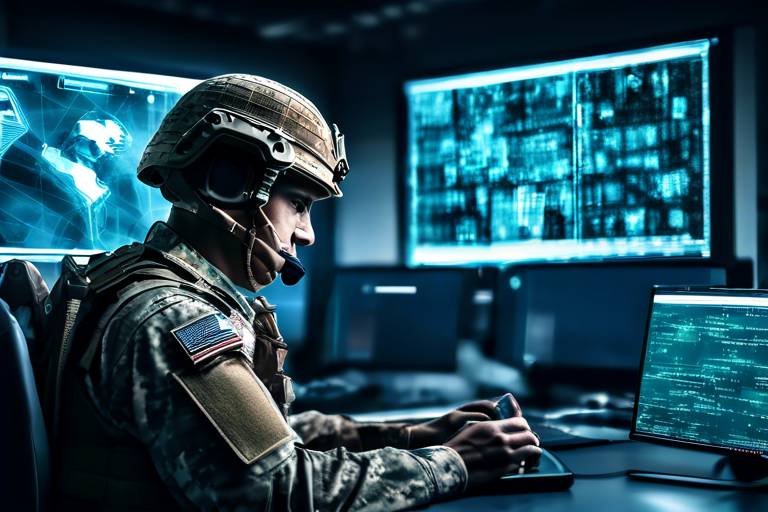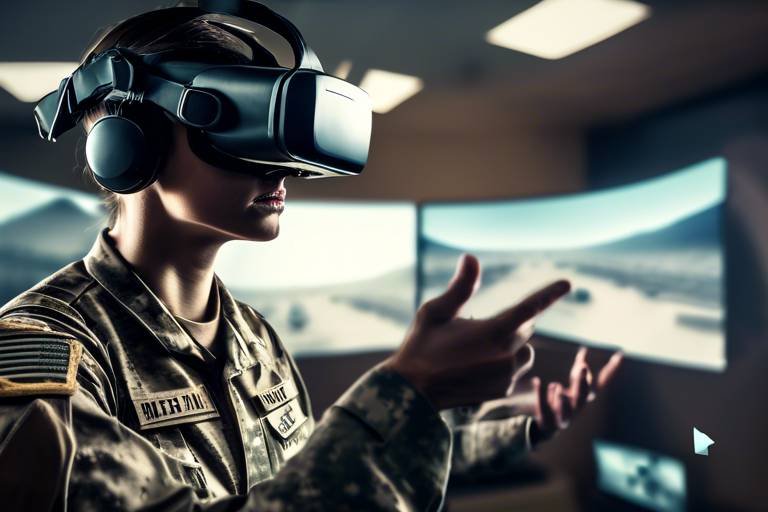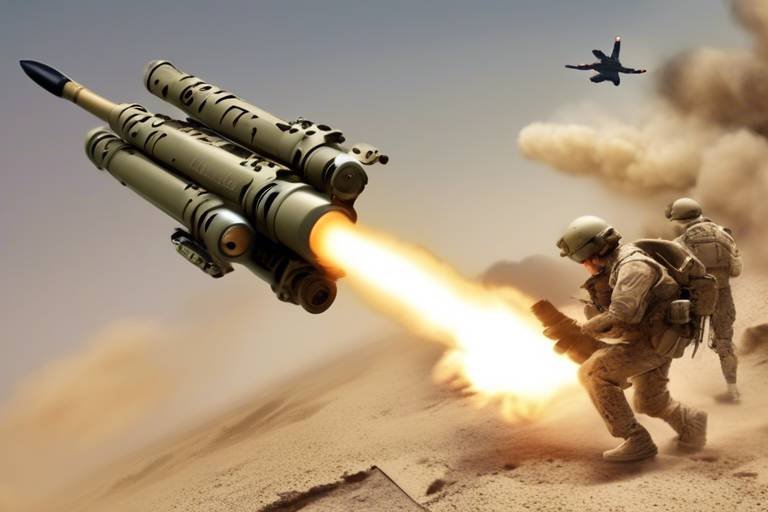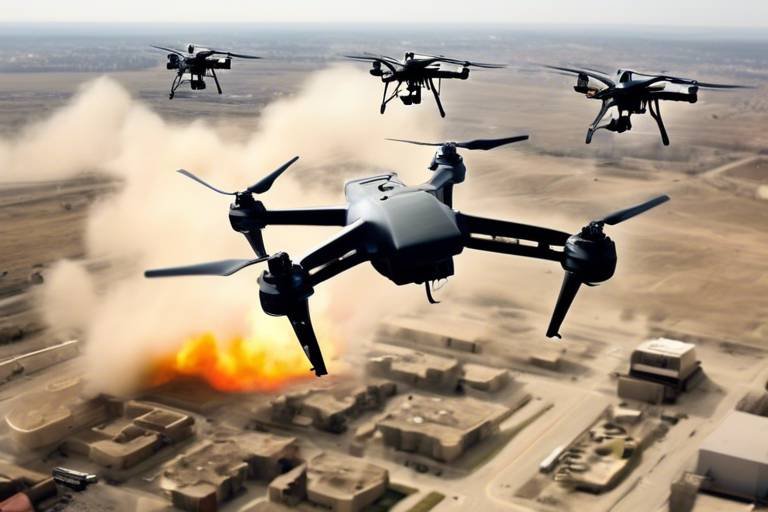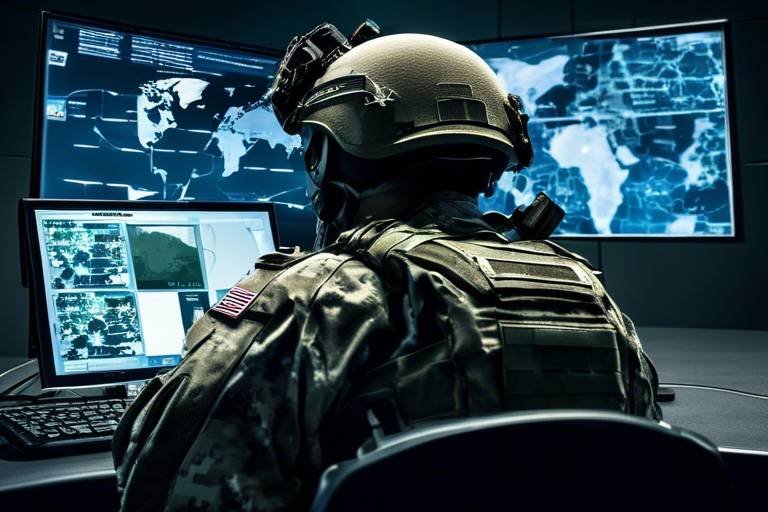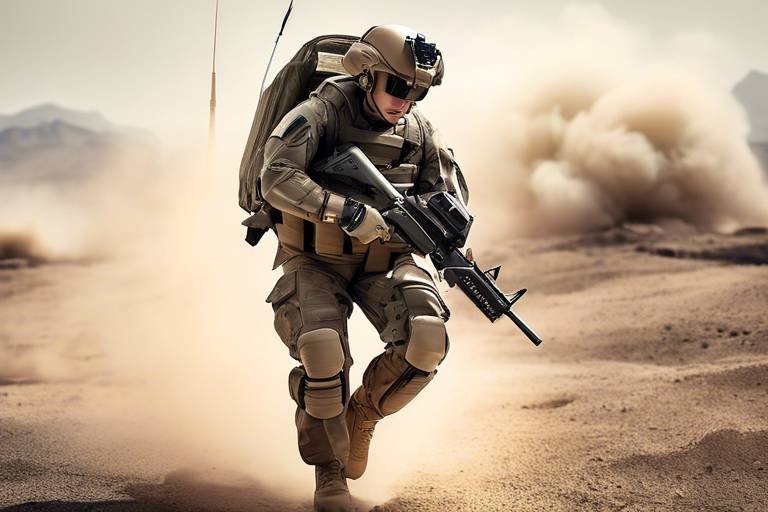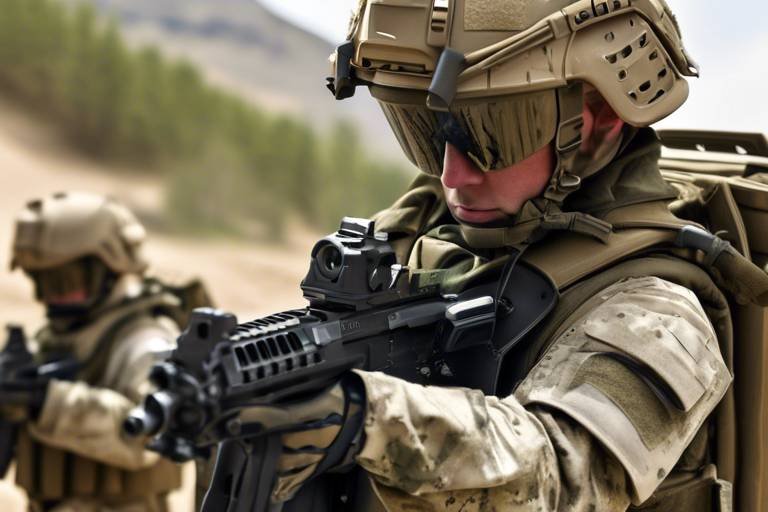The Role of Deep Learning in Enhancing Military Targeting
Deep learning technologies are not just a buzzword in tech circles; they are fundamentally transforming how military targeting systems operate. Imagine a world where military personnel can identify targets with unprecedented accuracy, making split-second decisions that could save lives and resources. This is not science fiction; it is the reality we are stepping into as deep learning algorithms take center stage in military operations. By leveraging vast amounts of data and mimicking the way our brains work, these technologies are enhancing decision-making processes in complex environments, ultimately leading to improved operational efficiency.
At its core, deep learning is a subset of artificial intelligence that processes information in layers, much like how our brains interpret sensory data. This capability is crucial for military applications, especially in targeting systems where precision is paramount. With every advancement in deep learning, we inch closer to a future where military operations can be conducted with greater accuracy, reduced collateral damage, and enhanced strategic planning. However, while the benefits are clear, we must also navigate the ethical implications and challenges that come with such powerful technology.
As we delve deeper into this topic, we will explore the various applications of deep learning in military targeting, from target recognition to real-time decision-making. We'll also discuss the challenges and limitations that accompany these advancements, including issues of data quality and algorithmic bias. Finally, we'll touch on the ethical considerations that arise with the use of autonomous systems in warfare and speculate on the future trends that could shape military strategies in the years to come.
Deep learning, a fascinating branch of artificial intelligence, is designed to mimic the neural networks of the human brain. It processes vast amounts of data through multiple layers of nodes, each learning to recognize patterns and features in the data. This capability is particularly relevant in military applications, where the ability to analyze complex datasets quickly can mean the difference between mission success and failure.
In military targeting systems, deep learning algorithms can analyze satellite imagery, sensor data, and other forms of intelligence to identify potential targets. This not only enhances the accuracy of target recognition but also allows for the rapid analysis of evolving situations on the battlefield. As we explore the various applications of deep learning in military operations, it becomes evident that this technology is not just an enhancement; it is a game-changer.
One of the most significant applications of deep learning in military targeting is in the realm of target recognition. Imagine a scenario where a military drone can identify and classify objects in real-time, distinguishing between a civilian vehicle and a potential threat. This capability is made possible by sophisticated deep learning algorithms that have been trained on vast datasets, enabling them to recognize patterns and features that human operators might overlook.
Success stories abound in military operations where deep learning has been employed for target recognition. For instance, during a recent conflict, deep learning algorithms were able to analyze aerial footage and identify enemy positions with remarkable accuracy. This not only improved the effectiveness of military strikes but also reduced the risk of collateral damage, showcasing the potential of these technologies in modern warfare.
Advanced image processing techniques powered by deep learning are revolutionizing how military personnel analyze aerial and satellite imagery. By employing methods such as convolutional neural networks (CNNs), military analysts can significantly enhance targeting precision. These techniques allow for the extraction of meaningful information from complex images, enabling faster and more accurate decision-making.
Convolutional Neural Networks (CNNs) are a cornerstone of deep learning image analysis. Designed to process pixel data, CNNs excel at identifying features within images, making them ideal for military applications where target detection and classification are critical. By analyzing layers of image data, CNNs can discern subtle differences between objects, ensuring that military personnel can make informed decisions based on accurate information.
To improve model performance, data augmentation techniques are employed to artificially increase the size of training datasets. This is crucial in military targeting, where the availability of high-quality data can often be limited. By using techniques such as flipping, rotating, and scaling images, military analysts can create more robust deep learning models that enhance the accuracy of target recognition systems.
In the fast-paced world of military operations, real-time decision-making is essential. Deep learning facilitates this by enabling systems to analyze data swiftly and provide actionable insights during critical missions. Imagine a battlefield scenario where a commander receives instant feedback on enemy movements, allowing for rapid strategic adjustments. This capability not only enhances operational effectiveness but also increases the safety of personnel on the ground.
Despite the many advantages of deep learning in military targeting, several challenges and limitations must be addressed. Issues related to data quality can significantly impact the effectiveness of deep learning algorithms. If the data used to train these systems is flawed or biased, the results can lead to incorrect targeting decisions, with potentially catastrophic consequences.
The use of deep learning in military applications raises important ethical concerns. As we move towards greater autonomy in targeting systems, the implications of autonomous decision-making become increasingly significant. Establishing guidelines to ensure responsible use is essential to prevent misuse and ensure that military operations remain within the bounds of international law.
As technology continues to evolve, so too will the applications of deep learning in military targeting. We can expect advancements that enhance the integration of artificial intelligence with human decision-making, leading to more effective and ethical military strategies. The future of warfare may very well hinge on our ability to harness these technologies responsibly while navigating the complex ethical landscape they present.
- What is deep learning? - Deep learning is a subset of artificial intelligence that uses neural networks to process data and recognize patterns.
- How does deep learning enhance military targeting? - By improving target recognition and enabling real-time decision-making, deep learning enhances the accuracy and efficiency of military operations.
- What are the ethical concerns related to deep learning in the military? - Ethical concerns include the potential for autonomous targeting decisions and the need for guidelines to ensure responsible use.
- What is a convolutional neural network? - A convolutional neural network is a type of deep learning model specifically designed for processing pixel data in images.

Understanding Deep Learning
Deep learning is not just a buzzword thrown around in tech circles; it’s a powerful subset of artificial intelligence that mimics the way our human brain processes information. Imagine your brain as a complex network of neurons firing away, making sense of the world around you. Deep learning operates on a similar principle, using layers of algorithms known as neural networks to analyze vast amounts of data. This technology is revolutionizing various fields, and its impact on military applications, particularly in targeting systems, is nothing short of remarkable.
At its core, deep learning involves training these neural networks on large datasets, allowing them to learn and make predictions or decisions without human intervention. Think of it like teaching a child to recognize different animals. Initially, you show them pictures of cats and dogs, and over time, they learn to distinguish between the two based on features like fur texture, size, and shape. In military contexts, deep learning systems can be trained to recognize targets through similar processes, enhancing their ability to identify and classify objects in real-time.
One of the key benefits of deep learning is its ability to improve accuracy in complex environments. Traditional algorithms often struggle with the nuances of real-world data, but deep learning algorithms thrive on complexity. They can process unstructured data, like images and videos, and extract meaningful insights that can assist military personnel in making informed decisions. This is particularly crucial in scenarios where split-second decisions can mean the difference between success and failure.
Moreover, the relevance of deep learning in military applications extends beyond just target recognition. It plays a significant role in various aspects of military operations, including:
- Data Analysis: Analyzing large volumes of data from various sources to identify patterns and trends.
- Predictive Maintenance: Anticipating equipment failures before they happen to ensure operational readiness.
- Cybersecurity: Detecting and responding to potential threats in real-time.
As we delve deeper into the applications of deep learning in military targeting systems, it becomes clear that this technology is not just about enhancing capabilities; it’s about redefining the very framework of military strategy and operations. However, with great power comes great responsibility, and understanding the implications of deep learning is crucial in ensuring that it is used ethically and effectively.
- What is deep learning? Deep learning is a subset of artificial intelligence that uses neural networks to analyze and process large amounts of data, mimicking the way the human brain operates.
- How is deep learning used in military targeting? Deep learning enhances military targeting by improving target recognition and classification, enabling real-time decision-making, and analyzing complex data sets.
- What are the ethical implications of deep learning in military applications? The use of deep learning in military contexts raises concerns about autonomous targeting, algorithm bias, and the need for human oversight in decision-making processes.

Applications in Target Recognition
Deep learning has become a game-changer in the field of military target recognition, dramatically transforming the way armed forces identify and classify objects on the battlefield. With the ability to process immense volumes of data rapidly, deep learning algorithms empower military personnel to make informed decisions with unprecedented accuracy and speed. Imagine being in a high-stakes situation where every second counts; deep learning can analyze images and data in real-time, allowing for immediate responses to threats. This capability not only enhances situational awareness but also significantly reduces the risk of collateral damage.
One of the most compelling applications of deep learning in military operations is its ability to recognize and classify targets from various sources, including aerial surveillance and satellite imagery. For instance, during a conflict, drones equipped with deep learning algorithms can autonomously scan the terrain, identifying vehicles, personnel, and other critical assets. This capability allows for more strategic planning and execution of missions. A report from the Defense Advanced Research Projects Agency (DARPA) highlighted that deep learning systems could improve target recognition accuracy by over 90%, showcasing the technology's potential to save lives and resources.
Moreover, deep learning models are designed to learn from vast datasets, continuously improving their recognition capabilities. This process is akin to teaching a child to recognize different animals; the more images they see, the better they become at identifying them. In military applications, this means that algorithms trained on diverse datasets can adapt to various environments and scenarios, enhancing their effectiveness in real-world conditions. The following table illustrates some notable applications of deep learning in military target recognition:
| Application | Description | Impact |
|---|---|---|
| Drone Surveillance | Utilizing drones for real-time target identification. | Enhanced situational awareness and quicker response times. |
| Satellite Imagery Analysis | Analyzing satellite images to detect enemy movements. | Improved strategic planning and operational efficiency. |
| Facial Recognition | Identifying individuals in crowded areas. | Increased security and threat assessment. |
Furthermore, deep learning's capability to conduct real-time analysis is invaluable in dynamic combat environments. For example, during military operations, the ability to quickly distinguish between friendly and enemy forces can prevent costly mistakes. This precision is achieved through advanced algorithms that can analyze patterns and features in the data, allowing for more nuanced decision-making. However, it’s important to remember that while technology enhances capabilities, human oversight remains crucial to validate the findings and ensure ethical considerations are met.
As we delve deeper into the future of military operations, the integration of deep learning into target recognition systems will continue to evolve. The ongoing research and development in this field hold the promise of even more sophisticated algorithms that can tackle increasingly complex scenarios. This evolution not only enhances operational effectiveness but also sets the stage for a new era in military strategy.
- What is deep learning? Deep learning is a subset of artificial intelligence that mimics human brain function to process large amounts of data.
- How does deep learning improve target recognition? It enhances target recognition by analyzing vast datasets quickly and accurately, allowing for real-time decision-making.
- What are the ethical concerns associated with deep learning in military applications? Ethical concerns include the potential for autonomous targeting and the need for human oversight to prevent misuse of technology.
- What future advancements can we expect in military targeting? We can expect more sophisticated algorithms, improved accuracy, and enhanced operational efficiency as technology continues to evolve.

Image Processing Techniques
In the realm of military targeting, powered by deep learning have become game-changers. These advanced methods allow military personnel to analyze vast amounts of visual data with unprecedented accuracy. Imagine being able to sift through thousands of images in mere seconds, pinpointing potential targets while filtering out irrelevant information. This is the power of deep learning in action.
One of the most significant advancements in this area is the use of Convolutional Neural Networks (CNNs). These networks are specifically designed to process pixel data, mimicking the way humans recognize patterns and objects. By training on large datasets, CNNs learn to identify features in images, such as edges, textures, and shapes, which are crucial for effective target detection. For instance, in aerial surveillance, CNNs can distinguish between military vehicles and civilian ones, significantly reducing the risk of collateral damage.
Moreover, the implementation of data augmentation strategies enhances the robustness of these models. Data augmentation involves artificially increasing the size of training datasets by applying transformations to existing images, such as rotations, flips, or color adjustments. This technique not only helps in combating overfitting but also improves the model's ability to generalize across different scenarios. As a result, military targeting systems become more reliable, even in challenging environments where visibility may be compromised.
To illustrate the impact of these image processing techniques, consider the following table that outlines some key methods and their applications:
| Technique | Description | Application |
|---|---|---|
| CNNs | Analyze pixel data for object recognition | Real-time target identification |
| Image Segmentation | Divides an image into segments for easier analysis | Identifying and isolating targets in complex backgrounds |
| Optical Flow Analysis | Tracks movement patterns in sequences of images | Monitoring enemy movements or changes in terrain |
These techniques not only enhance targeting precision but also facilitate faster decision-making processes. By leveraging deep learning, military operations can operate with a level of efficiency that was previously unimaginable. However, as we embrace these technological advancements, it’s essential to remain vigilant about their implications and ensure that they are used responsibly.
- What is deep learning? Deep learning is a subset of artificial intelligence that mimics the human brain's processing capabilities to analyze large datasets.
- How do CNNs work in military targeting? CNNs process pixel data to identify and classify objects in images, significantly improving target detection.
- What is data augmentation? Data augmentation is a technique that artificially increases the size of training datasets to enhance model performance.
- What are the ethical implications of using deep learning in military applications? Ethical concerns include the potential for autonomous targeting and the need for human oversight in decision-making processes.

Convolutional Neural Networks
Convolutional Neural Networks (CNNs) are a cornerstone of deep learning, particularly when it comes to image analysis in military targeting systems. Imagine your brain processing a visual scene—you're able to recognize objects, faces, and even emotions almost instantaneously. CNNs mimic this remarkable ability by employing a layered architecture that enables them to learn and extract features from images effectively. This is crucial in military applications, where the ability to accurately identify and classify targets can mean the difference between mission success and failure.
At their core, CNNs consist of several types of layers, each playing a specific role in the image processing pipeline:
- Convolutional Layers: These layers are responsible for detecting patterns, such as edges and textures, by applying various filters to the input image. Each filter focuses on a different aspect of the image, allowing the network to learn a rich representation of the visual data.
- Pooling Layers: After convolution, pooling layers down-sample the image, reducing its dimensionality while retaining essential features. This helps in minimizing computational load and preventing overfitting.
- Fully Connected Layers: At the end of the network, fully connected layers combine all the features learned from previous layers to make final predictions about the target class. This is akin to how our brain integrates information to arrive at a decision.
One of the standout advantages of CNNs in military targeting is their ability to process vast amounts of data quickly and accurately. For instance, during aerial surveillance missions, CNNs can analyze thousands of images in real-time, identifying potential threats or targets with impressive speed. This capability not only enhances operational efficiency but also aids in timely decision-making, which is critical in high-stakes environments.
Moreover, the adaptability of CNNs allows them to be trained on diverse datasets, which is vital for military applications that require recognition of various objects under different conditions. By using techniques such as transfer learning, where a pre-trained model is fine-tuned on specific military datasets, CNNs can achieve high accuracy even with limited training data. This flexibility is especially important in dynamic battlefield scenarios, where conditions can change rapidly.
In summary, Convolutional Neural Networks are more than just a technological advancement; they are a transformative force in military targeting systems. By mimicking human visual processing, CNNs provide unparalleled accuracy and efficiency, helping military personnel make informed decisions in complex and often unpredictable environments.
Q: What are Convolutional Neural Networks?
A: Convolutional Neural Networks (CNNs) are a type of deep learning model specifically designed for analyzing visual data. They utilize layers that perform convolutions to detect patterns and features in images.
Q: How do CNNs improve military targeting systems?
A: CNNs enhance military targeting systems by enabling real-time image analysis, improving target recognition accuracy, and facilitating quick decision-making during operations.
Q: What are the main components of a CNN?
A: The main components of a CNN include convolutional layers, pooling layers, and fully connected layers, each serving a unique function in processing and classifying images.
Q: Can CNNs be trained on limited datasets?
A: Yes, CNNs can be trained on limited datasets using techniques like transfer learning, which allows them to leverage knowledge from pre-trained models to improve performance on specific tasks.

Data Augmentation Strategies
In the realm of deep learning, particularly within military targeting systems, data augmentation stands out as a vital strategy for enhancing model performance. At its core, data augmentation involves artificially increasing the size and diversity of training datasets without the need for additional data collection. This is crucial in military applications where obtaining real-world data can be challenging, time-consuming, and sometimes risky. By employing various augmentation techniques, military analysts can create a more robust model capable of accurately identifying and classifying targets under varied conditions.
Imagine you're training a model to recognize enemy vehicles in different terrains and weather conditions. If your training dataset only includes images of vehicles in sunny weather, your model might struggle when faced with images from a rainy day or in a desert environment. This is where data augmentation comes into play, allowing the model to learn from a broader spectrum of scenarios. Common strategies include:
- Rotation: Rotating images at various angles helps the model learn to recognize objects from different perspectives.
- Flipping: Horizontal and vertical flips can simulate different viewpoints, making the model more versatile.
- Color Jittering: Adjusting brightness, contrast, and saturation ensures that the model can handle variations in lighting conditions.
- Scaling and Cropping: Changing the size of images and cropping them can help the model focus on specific areas of interest, which is particularly useful in identifying small targets.
These techniques not only enhance the model's ability to generalize from training data but also significantly reduce the risk of overfitting. Overfitting occurs when a model learns the training data too well, including its noise and outliers, leading to poor performance on unseen data. By diversifying the training dataset through augmentation, the model becomes more resilient and adaptable, improving its performance during actual military operations.
Furthermore, data augmentation strategies can be implemented in real-time, allowing military personnel to adapt their models on-the-fly as new data becomes available. This adaptability is crucial in dynamic environments where conditions can change rapidly. The ability to refine targeting systems continuously ensures that military operations remain effective and precise, ultimately leading to better decision-making and operational success.
In conclusion, data augmentation is not merely a technical enhancement; it is a strategic necessity in military targeting systems. By leveraging these techniques, military organizations can ensure that their deep learning models are not only accurate but also capable of adapting to the unpredictable nature of modern warfare.
- What is data augmentation? Data augmentation is a technique used to artificially increase the size and diversity of a training dataset by applying various transformations to existing data.
- Why is data augmentation important in military targeting? It enhances the robustness of deep learning models, ensuring they can accurately identify and classify targets under various conditions without the need for extensive real-world data collection.
- How does data augmentation prevent overfitting? By diversifying the training dataset, data augmentation helps the model generalize better, reducing the likelihood of it memorizing noise and outliers from the training data.
- Can data augmentation be applied in real-time? Yes, data augmentation techniques can be implemented in real-time, allowing military personnel to adapt their models as new data becomes available.

Real-time Decision Making
In the fast-paced world of military operations, is not just a luxury; it's a necessity. Imagine being in a high-stakes situation where every second counts. Deep learning technologies are stepping up to the plate, enabling military personnel to analyze vast amounts of data almost instantaneously. This capability is akin to having a highly trained assistant who can sift through mountains of information in the blink of an eye, presenting only the most relevant insights to decision-makers.
At the heart of this transformation is the ability to process data from various sources, including satellite imagery, drone feeds, and ground sensors. With deep learning algorithms, military systems can identify patterns and anomalies that might escape human attention. For example, during reconnaissance missions, these algorithms can quickly determine if a vehicle is hostile or civilian, allowing commanders to make informed decisions without delay.
Moreover, deep learning models are designed to continuously improve over time. As they encounter more data, they learn from their experiences, enhancing their predictive capabilities. This is similar to how a seasoned soldier becomes more adept with each mission. The result? A military force that can respond to threats with unparalleled speed and accuracy.
For instance, consider a scenario where a military unit is monitoring a conflict zone. By employing deep learning algorithms, they can:
- Analyze real-time video feeds to detect unusual movements or patterns.
- Cross-reference data from multiple sources to confirm the identity of potential threats.
- Provide actionable insights to commanders, who can then decide on the best course of action without hesitation.
This rapid analysis not only enhances operational effectiveness but also minimizes the risk of collateral damage. In today's complex battlefield, where the lines between combatants and civilians can blur, having the ability to make quick yet informed decisions can save lives.
However, this technology doesn't operate in a vacuum. It requires human oversight to interpret the results and make final decisions. While deep learning can provide the data and insights, it is ultimately the human element that ensures ethical considerations are taken into account. This partnership between machine and human is crucial for maintaining accountability and responsibility in military operations.
As we look to the future, the integration of deep learning in real-time decision making will only deepen. The potential for advancements is vast, promising even more sophisticated systems that can assist military personnel in navigating the complexities of modern warfare. The challenge lies in balancing the benefits of these technologies with the ethical implications they bring. After all, in the quest for efficiency and accuracy, we must never lose sight of our moral compass.
- What is real-time decision making in military operations?
Real-time decision making refers to the ability to analyze data and make informed decisions almost instantaneously during military operations, crucial for responding to threats effectively. - How does deep learning enhance decision making?
Deep learning enhances decision making by processing vast amounts of data from various sources, identifying patterns, and providing actionable insights quickly, which helps commanders make informed choices. - What role does human oversight play in deep learning applications?
Human oversight is essential to interpret the data provided by deep learning systems, ensuring that ethical considerations are taken into account and that decisions are made responsibly. - What are some challenges associated with real-time decision making?
Challenges include ensuring data quality, addressing algorithm bias, and maintaining a balance between technological capabilities and ethical implications.

Challenges and Limitations
While deep learning has brought about a significant transformation in military targeting systems, it is not without its . One of the primary concerns is the quality of the data used to train these algorithms. Inaccurate, incomplete, or biased data can lead to erroneous conclusions and decisions, potentially compromising mission success. Imagine trying to solve a complex puzzle with missing pieces; the end result is likely to be flawed. This analogy highlights how crucial high-quality data is in training deep learning models.
Another pressing issue is algorithm bias. If the data used to train these systems contains inherent biases, the algorithms will likely perpetuate those biases in their decision-making processes. This can lead to unfair targeting and unintended consequences in military operations. For instance, if a model is trained predominantly on data from one geographic region, it may struggle to accurately identify targets in others, leading to operational inefficiencies and ethical dilemmas.
Moreover, the reliance on automated systems raises the question of human oversight. In high-stakes environments, such as military operations, the need for human judgment cannot be overstated. While deep learning can process data at lightning speed, it lacks the nuanced understanding of context that a human operator possesses. Therefore, establishing a balance between automation and human involvement is critical to ensure that decisions made by these systems are both accurate and ethically sound.
Additionally, the complexity of deep learning models can hinder transparency. Many of these models operate as "black boxes," making it challenging to understand how they arrive at their conclusions. This opacity can be problematic, particularly when accountability is at stake. If a military operation goes awry due to a decision made by an algorithm, determining the cause can be a daunting task.
In summary, while deep learning offers tremendous potential for enhancing military targeting systems, it is essential to address these challenges. Ensuring data quality, mitigating algorithm bias, maintaining human oversight, and improving model transparency are all critical steps in harnessing the full power of this technology in a responsible manner.
- What are the main challenges of using deep learning in military targeting?
The main challenges include data quality, algorithm bias, the need for human oversight, and model transparency. - How does algorithm bias affect military operations?
Algorithm bias can lead to unfair targeting and operational inefficiencies, especially if the training data is not representative of diverse scenarios. - Why is human oversight important in military targeting systems?
Human oversight is crucial for ensuring that decisions made by automated systems are accurate and ethically sound, especially in high-stakes situations. - What steps can be taken to improve deep learning models in military applications?
Improving data quality, reducing bias, maintaining human involvement, and enhancing model transparency are essential for better performance.

Ethical Considerations
As we dive deeper into the world of deep learning in military applications, we can't ignore the profound ethical implications that come with it. The ability to harness advanced algorithms for targeting systems brings about a wave of innovation, but it also raises significant questions about accountability and moral responsibility. Who is to blame if an autonomous system makes a mistake? Is it the programmer, the military command, or the technology itself? These are not just hypothetical scenarios; they are real concerns that demand our attention.
One of the most pressing ethical dilemmas is the potential for autonomous targeting. Imagine a scenario where a drone, equipped with deep learning capabilities, identifies a target and executes an attack without human intervention. This situation could lead to unintended consequences, such as collateral damage or the loss of innocent lives. The challenge lies in ensuring that these systems are designed with strict guidelines to prevent misuse. As we embrace these technologies, we must also establish ethical frameworks that govern their deployment.
Moreover, the issue of algorithmic bias cannot be overlooked. Deep learning models are only as good as the data they are trained on. If the training data contains biases—whether racial, gender-based, or geographic—the resulting algorithms may perpetuate these biases in real-world applications. This could lead to disproportionate targeting of specific groups or areas, raising serious ethical concerns about fairness and justice in military operations. To mitigate this risk, regular audits of data sources and model outputs are essential.
To address these ethical challenges, it is crucial to involve a diverse group of stakeholders in the conversation. This includes not only military personnel and technologists but also ethicists, legal experts, and representatives from civil society. By fostering an inclusive dialogue, we can create comprehensive guidelines that prioritize human rights and ethical considerations in the development and deployment of deep learning technologies in military contexts.
In summary, while the integration of deep learning in military targeting presents exciting opportunities for enhanced operational efficiency, it also necessitates a careful examination of the ethical landscape. As we advance, we must remain vigilant and proactive in addressing these challenges to ensure that technology serves humanity rather than undermines it.
- What are the main ethical concerns regarding deep learning in military applications?
The main concerns include autonomous targeting, accountability for mistakes, algorithmic bias, and the need for human oversight. These issues highlight the importance of establishing ethical guidelines for responsible use.
- How can bias in deep learning algorithms impact military operations?
Bias in algorithms can lead to unfair targeting decisions, disproportionately affecting certain groups or areas, which raises serious ethical and moral questions about justice and accountability in military actions.
- What steps can be taken to ensure ethical use of deep learning technologies?
Involving a diverse group of stakeholders, conducting regular audits of data and algorithms, and establishing clear guidelines for the deployment of these technologies are essential steps to ensure ethical use.

Future Trends in Military Targeting
The landscape of military targeting is poised for a dramatic transformation as deep learning technologies continue to evolve. Imagine a future where military operations are not just reactive but proactively anticipate threats and opportunities. With advancements in deep learning, we can expect a surge in autonomous systems capable of making split-second decisions based on vast datasets, thereby enhancing operational efficiency and effectiveness.
One of the most exciting trends is the integration of edge computing with deep learning. This technology allows data to be processed closer to the source, reducing latency and enabling real-time analytics. For military targeting, this means that drones and other unmanned systems can analyze their surroundings instantly, making them more responsive to changing battlefield conditions. Picture a drone that can identify and classify targets without waiting for data to be sent back to a central command center—this is the future we are heading towards.
Moreover, the fusion of multi-modal data—combining data from various sources such as radar, satellite imagery, and on-ground sensors—will enhance the accuracy of target identification. By leveraging deep learning algorithms to analyze this diverse data, military forces can achieve a more comprehensive situational awareness. Imagine being able to visualize a battlefield in 3D with real-time updates, allowing commanders to make informed decisions based on a holistic view of the environment.
Another critical trend is the development of explainable AI in military applications. As deep learning models become more complex, understanding their decision-making processes is essential, especially in high-stakes environments like military operations. Future systems will likely incorporate features that provide transparency, allowing operators to comprehend why a particular target was identified or why a specific action was recommended. This transparency is vital for maintaining trust and accountability in autonomous systems.
As we look ahead, the potential for collaborative AI is also promising. Imagine a scenario where multiple autonomous systems work together seamlessly, sharing data and insights in real-time. This collaborative approach could significantly enhance targeting accuracy and operational success. For instance, a swarm of drones could communicate with each other to optimize their search patterns, ensuring that no area is overlooked during reconnaissance missions.
However, while these advancements offer exciting possibilities, they also come with challenges. The military must navigate the complexities of integrating these technologies into existing frameworks while ensuring they align with ethical standards and operational protocols. As we embrace the future of military targeting, it’s crucial to strike a balance between leveraging technological advancements and maintaining human oversight.
In conclusion, the future of military targeting powered by deep learning holds immense potential. With innovations in edge computing, multi-modal data fusion, explainable AI, and collaborative systems, we are on the brink of a new era in military operations. The key will be to harness these technologies responsibly, ensuring that they enhance our capabilities while adhering to ethical guidelines.
- What is deep learning in the context of military targeting? Deep learning is a subset of artificial intelligence that mimics the human brain's functions to analyze vast amounts of data, significantly improving target identification and decision-making processes in military operations.
- How does edge computing enhance military targeting? Edge computing allows data to be processed closer to its source, enabling real-time analytics and quicker decision-making, which is crucial for military operations.
- What are the ethical implications of using autonomous systems in military targeting? The use of autonomous systems raises concerns about accountability, decision-making in life-and-death situations, and the potential for algorithmic bias, necessitating clear guidelines and oversight.
- How can explainable AI improve trust in military applications? Explainable AI provides transparency in the decision-making processes of deep learning models, helping operators understand and trust the rationale behind target identification and actions.
Frequently Asked Questions
- What is deep learning and how does it relate to military targeting?
Deep learning is a subset of artificial intelligence that simulates the way the human brain processes information. In military targeting, it enhances the ability to analyze vast amounts of data, allowing for more accurate and efficient identification of targets in complex environments.
- How do deep learning algorithms improve target recognition?
Deep learning algorithms improve target recognition by utilizing advanced image processing techniques that can identify and classify objects in real-time. These algorithms learn from vast datasets, making them highly effective in recognizing patterns and distinguishing between different targets.
- What role do Convolutional Neural Networks (CNNs) play in military targeting?
CNNs are specially designed to process pixel data, making them crucial for image analysis in military targeting systems. They excel at detecting and classifying objects within images, enabling more precise targeting decisions based on visual data.
- What are data augmentation strategies and why are they important?
Data augmentation strategies artificially expand the size of training datasets by creating modified versions of existing data. This is important because it enhances the robustness of deep learning models, leading to improved performance in recognizing and classifying military targets.
- How does deep learning facilitate real-time decision-making in military operations?
Deep learning systems analyze incoming data rapidly, providing actionable insights during critical missions. This swift analysis allows military personnel to make informed decisions quickly, which is essential in high-stakes environments.
- What are some challenges associated with using deep learning in military targeting?
Challenges include issues related to data quality, potential algorithm bias, and the necessity for human oversight in decision-making processes. These factors can impact the effectiveness and ethical implications of deep learning applications in military contexts.
- What ethical considerations are involved in the use of deep learning for military applications?
The use of deep learning in military applications raises ethical concerns, particularly regarding autonomous targeting. It is crucial to establish guidelines to ensure responsible use and to address the potential consequences of machine-driven decisions in warfare.
- What future trends can we expect in military targeting with deep learning?
As technology continues to evolve, we can expect advancements in deep learning applications for military targeting, which may lead to enhanced operational effectiveness and new strategies in warfare. These trends will likely focus on improving accuracy, efficiency, and ethical considerations in military operations.



